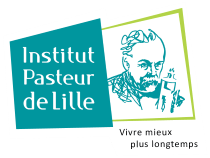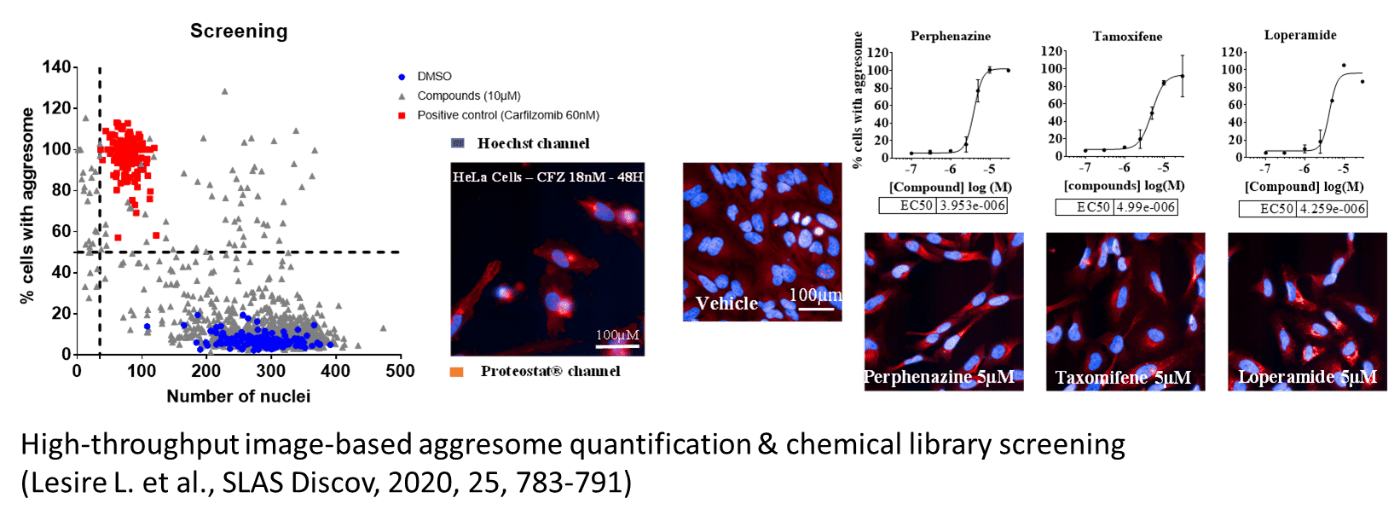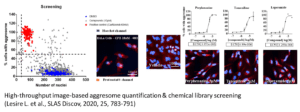Ariadne platform : High throughput and high content screening
Plateformes Lilloises en Biologie & Santé – PLBS – UMS 2014 – US 41

Présentation
ARIADNE is composed of two platforms, ARIADNE-Screening and ARIADNE-ADME, working independently but complementary. Their objective is to discover small chemical molecules useful in therapy or to explore the living, and to characterize their ADME properties. ARIADNE-Criblage brings together a set of expertise and equipment dedicated to the screening of biological disruptors such as small chemical molecules or siRNA libraries. ARIADNE-ADME allows to quantify the parameters which characterize the ability of molecules to be Absorbed, Distributed, Metabolized and Eliminated in vivo (ADME).
ARIADNE-Screening is composed of three units. The HTS unit allows the miniaturization of cellular or non-cellular pharmacological assays and the high-throughput screening of chemical libraries. It allows to evaluate at medium throughput the activity of chemical series under optimization and to explore their mechanism of action. The HCS-L2 and HCS-L3 High Content Screening units allow to perform high throughput and high content screening by quantitative microscopy in a L2 or L3 security environment.
Know-how and services offered :
The platform brings together a set of expertise and equipment dedicated to the screening of biological disruptors such as small chemical molecules or siRNA libraries. The equipment chain allows full or partial automation of the screening steps, from the plating of disruptors from chemical libraries or siRNA libraries, to the reading of results. The know-how and technical skills of the personnel allow the development of high-throughput miniaturized (96, 384-well plates) and automated tests for in vitro, in bacterio or in cellulo, target or phenotypic screening. ARIADNE benefits from access to chemical libraries, in particular the regional chemical library of approximately 200,000 chemical molecules, siRNA and miRNA libraries. The platform also has expertise in cell labeling for cell domiciliation, using CRISPR Cas9 approaches. Equipment are located in biosafety level 1 to 3 laboratories. ARIADNE-HTS in BSL-1 allows management of libraries and high-throughput screening on multimode plate readers (with measurements in fluorescence, luminescence, absorbance, etc…). ARIADNE-HCS, from the ImagInEx BioMed Equipex, use automated confocal microscopy methods. A first imaging system (IN cell Analyzer 6000 GE Healthcare) is fully automated in BSL-2. A second system (IN cell Analyzer 6500) is available in BSL-3. This so-called “non-destructive” technology allows the monitoring of the same sample over time both in the short term (dynamic phenomena) and in the long term (kinetics) and makes it possible to measure several parameters simultaneously on the same biological sample. Numerous tests can be implemented: Enzymatic tests, phenotypic or target cell tests, protein-protein interactions in vitro or in cellulo, Thermal Shift Assay (TSA) and monitoring of target engagement in cellulo by CETSA… The use of “Echo” acoustic technology for liquid nanotransfer makes it possible to test molecules in combination and in dose response.
Requests for ARIADNE-Screening can be sent by email to the scientific manager. They will be the subject of a discussion with the project leader. Projects meeting the platform specifications will be accepted in the order of arrival. Depending on the case, ARIADNE-Screening staff can train users for autonomous but paid access to the platform, establish quotes for a service, collaborate in a search for funding… Each project is monitored by a member of the management committee and by the technical manager.
As part of a partnership agreement, projects can be continued with the experts of Ariadne-Screening or collaborators towards the characterization of targets and the optimization of modulators: target identification and engagement, medicinal chemistry, measurement of physicochemical properties, ADME studies and pharmacokinetics in rodents. This last work can be carried out with the ARIADNE-ADME platform.
Highlights
The platform is organizing a thematic school on screening which will take place in the Hauts de France from September 20 to 23, 2022. Registration is done on the school’s website.
ARIADNE technicians, engineers and researchers are committed to finding a treatment for the Covid-19 pandemic
- A molecule active in vitro on SARS-Cov-2 infection was discovered by cell screening of a library of 2000 drugs on the HCS system in BSL-3. This discovery is the result of collaboration with Drs Sandrine Belouzard and jeran Dubuisson from the Lille Center for Infection and Immunity and researchers from the company Apteeus.
- The HTS screening of the entire ARIADNE library (approx. 100 000 compounds) has identified several chemical series active on the 3CLPro protease of SARS-Cov-2 at sub-micromolar concentrations. This project is being carried out with Dr Julie Charton from Unit U1177.
Members
The platform is labeled and supported by the Gis IBiSA.
Its steering committee brings together researchers from the Lille Infection and Immunity Center : Dr Priscille brodin and Dr Alain Baulard, as well as from Unit U1177 : Pr Benoît Déprez and Dr Florence Leroux.
Priscille BRODIN
DR Inserm, CIIL UMR9017 U1019
Benoit DEPREZ
Pr Univ Lille, U1177
Alain BAULARD
DR Inserm, CIIL UMR9017 U1019
Florence LEROUX
IR Inserm, U1177
Alexandre VANDEPUTTE
IE Univ Lille, CIIL UMR9017 U1019
Cyril COUTURIER
MCU Univ Lille, U1177
Valentin GUILLAUME
CE IPL, U1177
Julie DUMONT
AI Univ Lille, U1177
Nathalie DEBOOSERE
CE IPL, CIIL UMR 9017 U1019
Valérie LANDRY
CE IPL, U1177
Adrien HERLEDAN
IE Inserm, U1177
Sandrine WARENGHEM
Tech IPL, U1177
Publications
Lesire, L., Chaput, L., Cruz De Casas, P., Rousseau, F., Piveteau, C., Dumont, J., Pointu, D., Déprez, B., and Leroux, F. (2020).
High-Throughput Image-Based Aggresome Quantification.
SLAS Discov 25, 783-791.
Moraski, G.C., Deboosère, N., Marshall, K.L., Weaver, H.A., Vandeputte, A., Hastings, C., Woolhiser, L., Lenaerts, A.J., Brodin, P., and Miller, M.J. (2020).
Intracellular and in vivo evaluation of imidazo[2,1-b] thiazole-5-carboxamide anti-tuberculosis compounds.
PLoS One 15, e0227224.
Herledan, A., Andres, M., Lejeune-Dodge, A., Leroux, F., Biela, A., Piveteau, C., Warenghem, S., Couturier, C., Deprez, B., and Deprez-Poulain, R. (2020).
Drug Target Engagement Using Coupled Cellular Thermal Shift Assay-Acoustic Reverse-Phase Protein Array.
SLAS Discov 25, 207–214.
Blondiaux, N., Moune, M., Desroses, M., Frita, R., Flipo, M., Mathys, V., Soetaert, K., Kiass, M., Delorme, V., Djaout, K., Trebosc, V., Kemmer, C., Wintjens, R., Wohlkönig, A., Antoine, R., Huot, L., Hot, D., Coscolla, M., Feldmann, J., Gagneux, S., Locht, C., Brodin, P., Gitzinger, M., Déprez, B., Willand, N., and Baulard, A. R. (2017).
Reversion of antibiotic resistance in Mycobacterium tuberculosis by spiroisoxazoline SMARt-420.
Science 355, 1206–1211.


